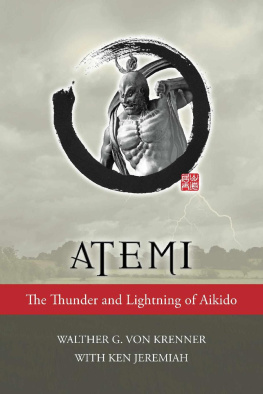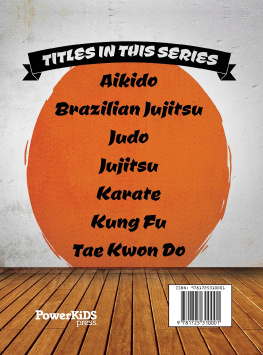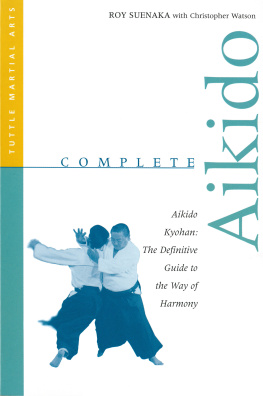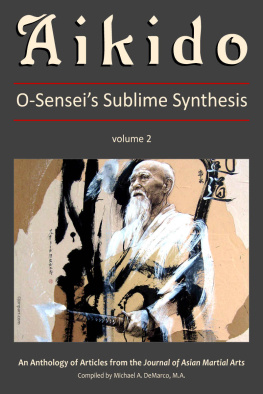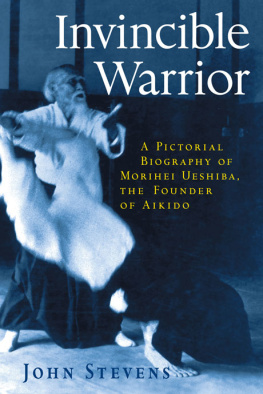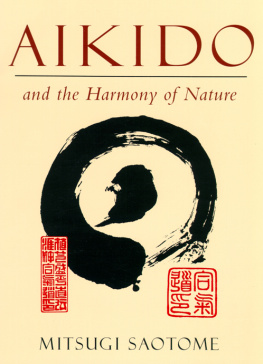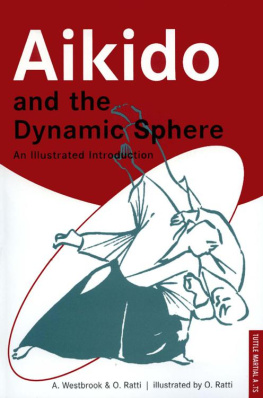
The Thunder and Lightning of Aikido

Walther G. von KrennerWith Ken Jeremiah
www.TambuliMedia.com Spring House, PA USA
DISCLAIMER
The author and publisher of this book DISCLAIM ANY RESPONSIBILITY over any injury as a result of the techniques taught in this book. Readers are advised to consult a physician about their physical condition before undergoing any strenuous training or dangerous physical activity. This is a martial arts book and details dangerous techniques that can cause serious physical injury and even death. Practice and training require a fit and healthy student and a qualified instructor.
First Published on March 31, 2016 by Tambuli Media
2016 Walther G. von Krenner
ISBN-13: 978-0692671825
ISBN-10: 069267182X
Library of Congress Control Number: 2016935149
All Rights Reserved. No part of this publication may be reproduced or utilized in any form or by any means, electronic or mechanical, including photocopying, recording, or by any information storage and retrieval system, without prior written permission from the Publisher or Author.
Edited by: Victoria Tuoati
Cover Art by: Walther G. von Krenner
Interior by: Summer Bonne
ACKNOWLEDGMENTS
I would like to express thanks and gratitude to my early Aikido teachers: Ueshiba Kisshomaru (who was Waka Sensei when I was at Hombu Dojo), Ueshiba Morihei (O-Sensei), and Tohei Koichi, my friend and Chief Instructor at Hombu. In addition, I am grateful to Shimizu Kenji, who was very kind and helpful when I first arrived in Tokyo, and Takahashi Isao, my mentor and guide. Thanks also to Dr. Robert Frager, a longtime friend who provided a lot of help and support at Hombu and beyond. I am also grateful to the many other teachers I have encountered on my long Budo journey who influenced my thinking in Zen and Art, which in turn shaped and contributed to my Aikido. Their teachings live on in my Art and my life.
Thanks to Ken Jeremiah, who provided invaluable help editing, rewriting, and handling such an undertakings frustrating aspects, and encouraging me to write this book in the first place.
Last but not least, special thanks to my wife Hana, who stood by me through all those years of Aikido and Budo training.
Walther G. von Krenner
Sandokan Aikido
Acknowledgmentsv
PUBLISHERS FOREWORD
In 1969, the year of my birth, the book Aikido Complete, by Yoshimitsu Yamada, was published. I purchased a tattered copy in a second-hand book shop after my 10th birthday, and wondered at the ability of the sensei to control his opponent by manipulating the joints of his wrist and arm. A few years later I purchased Aikido and the Dynamic Sphere, by Oscar Ratti and Adele Westbrook. This book has become a classic and Rattis nimble line drawings have been borrowed and copied for decades. I befriended Oscar, and remember with love and admiration the times spent with him in his private studio in New York City.
I was able to first visit Japan in 1993 en route to the Philippines, where I was conducting research on Filipino martial arts. My first books were published by Charles E. Tuttle Co in Tokyo, so I took this opportunity to visit my publisher. My editor, Alexander DC Kask, introduced me to several aikidoka, including Aikido Journal editor, Diane Skoss, and her husband Meik Skoss, who was a student of the legendary Donn F. Draeger.
I immediately fell in love with Japanese culture, traditions and food. I made a lotof friends in Japan and relocated there two years later to serve as martial arts editorat Tuttle. I worked and lived near the Kodokan, world headquarters for Judo, andobserved many classes and demonstrations of traditional Japanese Budo and Bujutsu,including aikido, at the Budokan and various Shinto shrines.
I also had occasion to visit the hombu dojo of Gozo Shioda sensei, one of Morihei Ueshibas original students. I observed a long class for police officers and was impressed with the discipline of both teacher and student. Almost 60 minutes were spent on a single technique; a straight arm bar takedown against an overhead attack. The techniques were done with purpose, intention, and no one just went through the moves. By the end of the session the officers aikidogi (uniforms) were stained with blood around the knees, from all the hard falls. I was impressed.
Today it seems like Aikido has fallen into a New Age art, where going with the flow and allowing your partner to throw you is more important than mastering the dynamic movements that OSensei envisioned. But this is not always the case and so I feel honored to have the chance to publish a book on Aikido by Walther von Krenner, a sensei I respect and admire, who is a standard bearer of the traditional Aikido of Osensei. With the detailed assistance of his student, Ken Jeremiah, Tambuli Media

is proud to bring you,
Atemi: The Lightning and Thunder of Aikido.Dr. Mark Wiley
Publisher, Tambuli Media March 16, 2016
CONTENTS
Introduction ...............................................................................................1
Aikidos Striking Techniques ................................................................ 5
Tohei Koichi (1920-2011) ................................................................... 6
O-Senseis Martial Arts Background ..................................................... 9
The Omoto-kyo Connection ............................................................... 9
Aikidos Misconceptions .................................................................... 11
Aikidos Martial Efficacy .................................................................... 12
PART I Shodan (Beginner) Level: An Introduction to Atemi-Waza ....... 15
1 Aikido Attacks ............................................................................. 17
Shomenuchi ................................................................................ 19
Balance and Centering ................................................................ 21
Yokomenuchi .............................................................................. 22
Tsuki ........................................................................................... 25
Grabbing Attacks ........................................................................ 28
Sen (Initiative) ............................................................................ 30
2 Striking in all Aikido Pinning Techniques .................................... 35
Ikkyo (Ude Osae): Technique Number One ................................ 35
Nikkyo (Kote Mawashi): Technique Number Two ...................... 46
Suki (Defensive Openings) and Atemi ......................................... 52
Uke-mi........................................................................................ 56
Sankyo (Kote Hineri): Technique Number Three ........................ 58
Katatedori ................................................................................... 58
Ju Yoku Go o Seisu: Softness Controls Hardness ......................... 61
Full Body Control ....................................................................... 62
Technical Variation from the Same Attack ................................... 66
From a Tsuki (Thrust) ................................................................. 67

